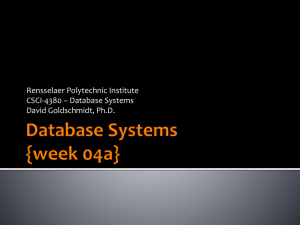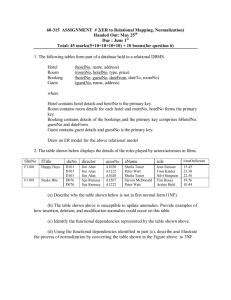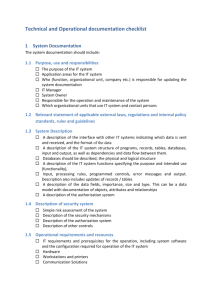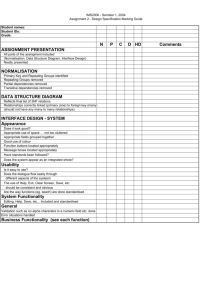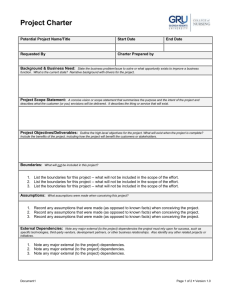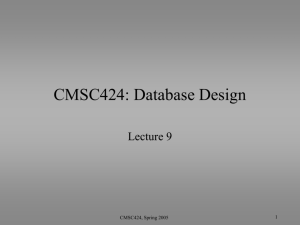csci4380-week03b - Rensselaer Polytechnic Institute
advertisement
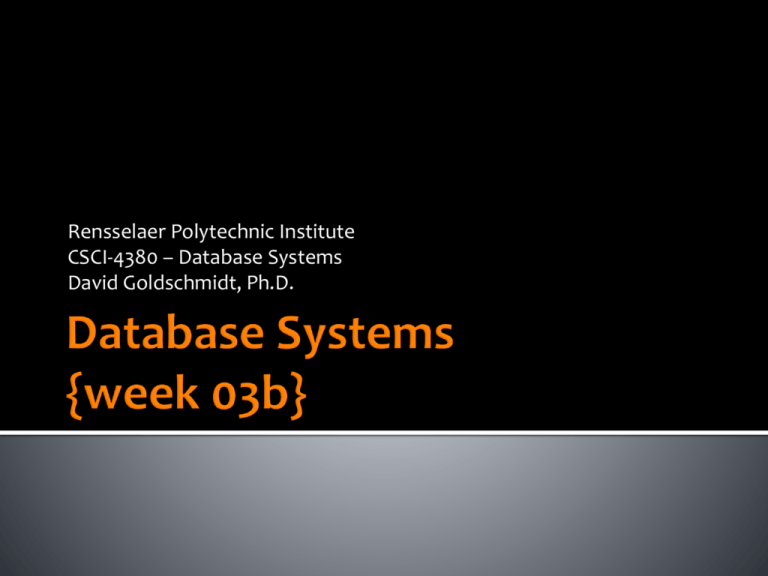
Rensselaer Polytechnic Institute
CSCI-4380 – Database Systems
David Goldschmidt, Ph.D.
Given a set of attributes X, the
closure X+ is the set of attributes
functionally determined by X
Given a relation R and a set F of functional
dependencies, we need a way to find
whether a functional dependency X Y is
true with respect to F
Given relation R with attributes A, B, C, D, E
and A BC, CD E, BE C
AE _____?
From reflexivity, AE+ = { A, E }
From A BC, AE+ = { A, B, C, E }
No other rules are applicable or add to AE+
We conclude that AE ABCE or simply AE BC
Or AE A, AE B, AE C, and AE E
Given a set F of functional dependencies,
the closure X+ of a set of attributes X is
determined by the following algorithm:
Initialize X+ to X
Repeat until X+ does not change:
▪ Find any unapplied functional dependency Y Z
in F such that Y X+
▪ Set X+ = X+ Z
A key K for a given relation R is a minimal set
of attributes A1, A2, ..., An such that closure
{A1, A2, ..., An}+ is the set of all attributes of R
MusicGroup(name, artist, genre, dateformed,
datefirstjoined)
name genre dateformed
name artist datefirstjoined
K must be (name, artist) because K+ = {name,
artist, genre, dateformed, datefirstjoined}
Given a set F of functional dependencies,
closure F+ is the set of all functional
dependencies implied by F
F+ can be found using the set of inference rules
(reflexivity, transitivity, augmentation, etc.)
Sets F1 and F2 of functional dependencies
are considered equal if they have the same
closure (i.e. F1+ = F2+)
In addition to determining closure F+ for
set F of functional dependencies, we can
also derive any functional dependency that
follows from F via Armstrong’s axioms:
Reflexivity (if Y X, then X Y)
Augmentation (if X Y, then XZ YZ)
Transitivity (if X Y and Y Z, then X Z)
Given a set F of functional dependencies,
any set of functional dependencies that’s
equivalent to F is called a basis
We limit the possibilities by requiring
that each dependency has a single
attribute on the right-hand side
How many bases are there for a relation R
with n functional dependencies in F?
A minimal basis for a relation R is a basis B
that satisfies the following conditions:
All functional dependencies in B have
singleton right-hand sides
If any functional dependency is removed from B,
the result is no longer a basis
If any left-hand side attribute is removed from
a functional dependency of B, the result is no
longer a basis
Given basis B, we can determine whether it
is a minimal basis via the algorithm below:
For each functional dependency X Y in B,
check if B – { X Y } still implies X Y
▪ if so, remove X Y
For each functional dependency XW Y in B,
check if X+ is the same with respect to F
and ( F – { XW Y } ) { X Y }
▪ if so, replace XW Y with X Y
Given relation R( A, B, C, D ) and
functional dependencies AB C,
C D, and D A
What are the keys of R?
What are the superkeys of R that are not keys?
Is the given set of functional dependencies a
basis? Is it a minimal basis?
What’s wrong with the relation below?
MusicGroup( name, artist, genre,
dateformed, datefirstjoined )
i.e. how can tuples
become corrupted
or incorrect?
Without normalization, problems with
relations include:
Unnecessary redundancy
Insert anomalies
Update anomalies
Delete anomalies
Splitting a relation into two (more specific)
relations is called decomposition
The objective is to have each
resulting relation be atomic
i.e. each relation should contain
only information related to the key
A given relation R with set F of functional
dependencies is in BCNF if and only if all
functional dependencies X Y in F are:
either trivial (i.e. Y X)
or X is a superkey of R
If relation R is not in BCNF, it is possible to
use decomposition to transform R to BCNF
Given a set F of functional dependencies for
relation R( A1, A2, ..., An ) that is not in BCNF:
Convert F to a minimal basis
Find an X Y that violates BCNF
Compute closure X+
Decompose R into:
▪ R1 containing all attributes of X+
▪ R2 containing { A1, A2, ..., An } – ( X+ – X )
Project functional dependencies onto R1 and R2
Given relation R( A, B, C, D, E ) and
functional dependencies AB AC,
CE D, B A, and D AE
What are the keys of R?
What are the superkeys of R that are not keys?
Is the given set of functional dependencies a
basis? Is it a minimal basis?
Is relation R in BCNF? If not, decompose R such
that it is in BCNF


